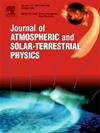Efficient three-source model for Schumann resonance
IF 1.8
4区 地球科学
Q3 GEOCHEMISTRY & GEOPHYSICS
Journal of Atmospheric and Solar-Terrestrial Physics
Pub Date : 2024-12-01
DOI:10.1016/j.jastp.2024.106395
引用次数: 0
Abstract
An efficient and simple model of global thunderstorm activity is described, which allows computing the diurnal and seasonal variations of the peak frequency of the first Schumann resonance (SR) mode. The model results are compared with the long-term monitoring of the diurnal - seasonal variations of the first SR frequency recorded in the vertical electric field component. The records were performed at the Hungarian Széchenyi István Geophysical Observatory or the Nagycenk Geophysical observatory (NCK; 47.6°N, 16.7°E). They cover the 16-year period ranging from Jan. 1994 to Dec. 2009. Comparison of model data with experimental observations allowed formulating the following conclusions. The model of the global thunderstorm activity is rather simple, it suggests that position of the global thunderstorm centers in Asia, Africa, and America varies from month to month, but it recurs from year to year. The only exception in spatial parameters is the effective width of the area occupied by lightning strokes, which is found from the observational data. Diurnal variations in thunderstorm intensity correspond to classical WMO data. In spite of its simplicity, the model is quite efficient; it allows accurately compute the diurnal variations of the first mode peak frequency. Deviations of the model f1 values from those observed experimentally do not exceed 1% while the cross-correlation coefficient of their temporal variations is equal to 0.5–0.6. Authors hope to apply this model in future studies, as well as in interpreting observations at other field sites. Extension of comparable data will clarify the effective parameters of the global thunderstorm activity serving as the source of SR oscillations.
舒曼共振的高效三源模型
本文描述了一种有效而简单的全球雷暴活动模式,该模式可以计算第一舒曼共振(SR)模态峰值频率的日变化和季节变化。将模型结果与垂直电场分量记录的第一次SR频率的日-季节变化长期监测结果进行了比较。这些记录是在匈牙利sz chenyi István地球物理观测站或Nagycenk地球物理观测站(NCK;北纬47.6°,东经16.7°E)。它们涵盖了从1994年1月到2009年12月的16年期间。将模型数据与实验观测数据进行比较,可以得出以下结论。全球雷暴活动的模式比较简单,它表明亚洲、非洲和美洲的全球雷暴中心的位置逐月变化,但每年都是重复的。空间参数中唯一的例外是雷击所占区域的有效宽度,这是由观测资料得出的。雷暴强度的日变化符合WMO的经典数据。尽管它很简单,但这个模型是相当有效的;它允许精确地计算第一模峰值频率的日变化。模型f1值与实验观测值的偏差不超过1%,其时间变化的相互相关系数为0.5 ~ 0.6。作者希望将该模型应用于未来的研究,以及解释在其他野外地点的观察结果。可比较资料的扩展将澄清作为SR振荡源的全球雷暴活动的有效参数。
本文章由计算机程序翻译,如有差异,请以英文原文为准。
求助全文
约1分钟内获得全文
求助全文
来源期刊

Journal of Atmospheric and Solar-Terrestrial Physics
地学-地球化学与地球物理
CiteScore
4.10
自引率
5.30%
发文量
95
审稿时长
6 months
期刊介绍:
The Journal of Atmospheric and Solar-Terrestrial Physics (JASTP) is an international journal concerned with the inter-disciplinary science of the Earth''s atmospheric and space environment, especially the highly varied and highly variable physical phenomena that occur in this natural laboratory and the processes that couple them.
The journal covers the physical processes operating in the troposphere, stratosphere, mesosphere, thermosphere, ionosphere, magnetosphere, the Sun, interplanetary medium, and heliosphere. Phenomena occurring in other "spheres", solar influences on climate, and supporting laboratory measurements are also considered. The journal deals especially with the coupling between the different regions.
Solar flares, coronal mass ejections, and other energetic events on the Sun create interesting and important perturbations in the near-Earth space environment. The physics of such "space weather" is central to the Journal of Atmospheric and Solar-Terrestrial Physics and the journal welcomes papers that lead in the direction of a predictive understanding of the coupled system. Regarding the upper atmosphere, the subjects of aeronomy, geomagnetism and geoelectricity, auroral phenomena, radio wave propagation, and plasma instabilities, are examples within the broad field of solar-terrestrial physics which emphasise the energy exchange between the solar wind, the magnetospheric and ionospheric plasmas, and the neutral gas. In the lower atmosphere, topics covered range from mesoscale to global scale dynamics, to atmospheric electricity, lightning and its effects, and to anthropogenic changes.
 求助内容:
求助内容: 应助结果提醒方式:
应助结果提醒方式:


